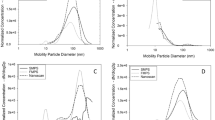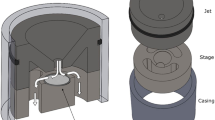Abstract
Surface area was estimated by three different methods using number and/or mass concentrations obtained from either two or three instruments that are commonly used in the field. The estimated surface area concentrations were compared with reference surface area concentrations (SAREF) calculated from the particle size distributions obtained from a scanning mobility particle sizer and an optical particle counter (OPC). The first estimation method (SAPSD) used particle size distribution measured by a condensation particle counter (CPC) and an OPC. The second method (SAINV1) used an inversion routine based on PM1.0, PM2.5, and number concentrations to reconstruct assumed lognormal size distributions by minimizing the difference between measurements and calculated values. The third method (SAINV2) utilized a simpler inversion method that used PM1.0 and number concentrations to construct a lognormal size distribution with an assumed value of geometric standard deviation. All estimated surface area concentrations were calculated from the reconstructed size distributions. These methods were evaluated using particle measurements obtained in a restaurant, an aluminum die-casting factory, and a diesel engine laboratory. SAPSD was 0.7–1.8 times higher and SAINV1 and SAINV2 were 2.2–8 times higher than SAREF in the restaurant and diesel engine laboratory. In the die casting facility, all estimated surface area concentrations were lower than SAREF. However, the estimated surface area concentration using all three methods had qualitatively similar exposure trends and rankings to those using SAREF within a workplace. This study suggests that surface area concentration estimation based on particle size distribution (SAPSD) is a more accurate and convenient method to estimate surface area concentrations than estimation methods using inversion routines and may be feasible to use for classifying exposure groups and identifying exposure trends.


Similar content being viewed by others
References
Accuratus (2009) Aluminum oxide, Al2O3. http://www.accuratus.com/alumox.html. Accessed 19 April 2010
Bell TE (2007) Understanding risk assessment of nanotechnology. National Nanotechnology Initiative web. http://www.nano.gov/Understanding_Risk_Assessment.pdf. Accessed 19 April 2010
Brown DM, Wilson M, MacNee W, Stone V, Donaldson K (2001) Size-dependent proinflammatory effects of ultrafine polystyrene particles: a role for surface area and oxidative stress in the enhanced activity of ultrafines. Toxicol Appl Pharmacol 175(3):191–199
Faux SP, Tran CL, Miller BG, Jones AD, Monteiller C, Donaldson K (2003). In vitro determinants of particulate toxicity: the dose-metric for poorly soluble dusts. Research Report 154, Suffolk, UK, Health and Safety Executive
Fiebig M, Stein C, Schröder F, Feldpausch P, Petzold A (2005) Inversion of data containing information on the aerosol particle size distribution using multiple instruments. J Aerosol Sci 36:1353–1372
Hach (2010) Met One HHPC-6 Handheld optical particle counter http://www.hach.com/fmmimghach?/19588%7C1. Accessed 22 May 2011
Hämeri K, Koponen I, Aalto P, Kulmala M (2002) The particle detection efficiency of the TSI-3007 condensation particle counter. J Aerosol Sci 33:1463–1469
Hougaard KS, Jensen KA, Nordly P, Taxvig C, Vogel U, Saber AT, Wallin H (2008) Effects of prenatal exposure to diesel exhaust particles on postnatal development, behavior, genotoxicity and inflammation in mice. Part Fibre Toxicol 5:3
ICRP (1994) International Commission on Radiological Protection Publication 66 Human Respiratory Tract Model for Radiological Protection. Pergamon, Elsevier Science Ltd., Oxford
Kandlikar M, Ramachandran G (1999) Inverse methods for analysing aerosol spectrometer measurements: a critical review. J Aerosol Sci 30(4):413–437
Ku BK, Maynard AD (2005) Comparing aerosol surface-area measurements of monodisperse ultrafine silver agglomerates by mobility analysis, transmission electron microscopy and diffusion charging. J Aerosol Sci 36:1108–1124
Kuehn TH (2008) Characterization of effluents from additional cooking appliances. Report 1375. ASHRAE
Lasdon LS, Waren AD, Jain A, Ratner M (1978) Design and testing of a generalized reduced gradient code for nonlinear programming. ACM Trans Math Softw (TOMS) 4(1):34–50
Maynard AD (2003) Estimating aerosol surface area from number and mass concentration measurements. Ann Occup Hyg 47:123
Maynard AD, Maynard RL (2002) A derived association between ambient aerosol surface area and excess mortality using historic time series data. Atmos Environ 36:5561–5567
Nel A, Xia T, Mädler L, Li N (2006) Toxic potential of materials at the nanolevel. Science 311(5761):622
NIOSH (1994) Particulates not otherwise regulated, total (0500). In: NIOSH Manual of Analytical Methods, National Institute for Occupational Safety and Health (NIOSH), Cincinnati
Oberdörster G (2000) Toxicology of ultrafine particles: in vivo studies. Philos Trans R Soc Lond A 358(1775):2719
Oberdörster G, Oberdörster E, Oberdörster J (2005) Nanotoxicology: an emerging discipline evolving from studies of ultrafine particles. Environ Health Perspect 113:823
Park JY, Raynor PC, Maynard AD, Eberly LE, Ramachandran G (2009) Comparison of two estimation methods for surface area concentration using number concentration and mass concentration of combustion-related ultrafine particles. Atmos Environ 43:502–509
Park JY, Ramachandran G, Raynor PC, Eberly LE, Olson G (2010) Comparing exposure zones by different exposure metrics using statistical parameters: contrast and precision. Ann Occup Hyg 54(7):799
Ramachandran G, Vincent JH (1997) Evaluation of two inversion techniques for retrieving health-related aerosol fractions from personal cascade impactor measurements. Am Ind Hyg Assoc J 58(1):15–22
Ramachandran G, Johnson EW, Vincent JH (1996) Inversion techniques for personal cascade impactor data. J Aerosol Sci 27:1083–1097
Ramachandran G, Adgate JL, Pratt GC, Sexton K (2003) Characterizing indoor and outdoor 15-minute average PM2.5 concentrations in urban neighborhoods. Aerosol Sci Technol 37:33–45
Rappaport SM, Kupper LL (2008) Quantitative exposure assessment, Lulu Press
Shin P, Shin WG, Pui DYH, Fissan H, Neumann S, Trampe A (2007) Calibration and numerical simulation of nanoparticle surface area monitor (TSI Model 3550 NSAM). J Nanopart Res 9:61–69
Siegmann K, Scherrer L, Siegmann H (1998) Physical and chemical properties of airborne nanoscale particles and how to measure the impact on human health. J Mol Struct THEOCHEM 458:191–201
Sreenath A (2009) Personal communication. TSI Inc.
Tran C, Buchanan D, Cullen R, Searl A, Jones AD, Donaldson K (2000) Inhalation of poorly soluble particles II. Influence of particle surface area on inflammation and clearance. Inhalation Toxicol 12(12):1113–1126
Woo KS, Chen DR, Pui DYH, Wilson WE (2001) Use of continuous measurements of integral aerosol parameters to estimate particle surface area. Aerosol Sci Technol 34:57–65
Zhiqiang Q, Siegmann K, Keller A, Matter U, Scherrer L, Siegmann H (2000) Nanoparticle air pollution in major cities and its origin. Atmos Environ 34:443–451
Acknowledgments
We thank TSI, Inc. for the instrumentation and technical support for this study, in particular Dr. Avula Sreenath’s help with calibration data and the Campus Club at the University of Minnesota, QX Inc., and the Center for Diesel Research in Department of Mechanical Engineering at University of Minnesota for allowing us to collect samples in their workplaces. Financial support for this project was provided by 3 M Company and the Midwest Center for Occupational Health and Safety (MCOHS) paper.
Author information
Authors and Affiliations
Corresponding author
Rights and permissions
About this article
Cite this article
Park, J.Y., Ramachandran, G., Raynor, P.C. et al. Estimation of surface area concentration of workplace incidental nanoparticles based on number and mass concentrations. J Nanopart Res 13, 4897 (2011). https://doi.org/10.1007/s11051-011-0469-x
Received:
Accepted:
Published:
DOI: https://doi.org/10.1007/s11051-011-0469-x




